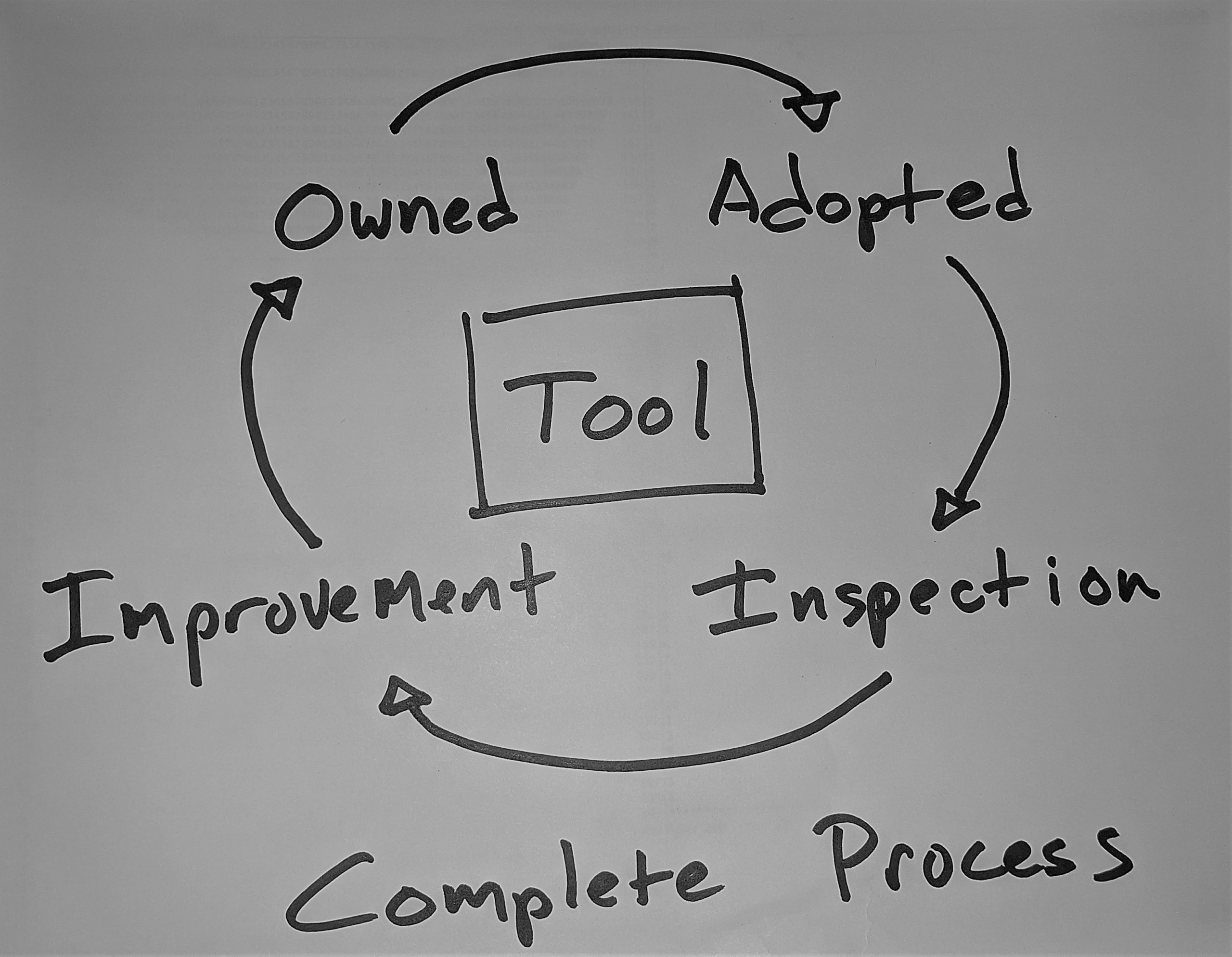Mechanisms are complete processes built around a tool, owned by a leader that gets adopted broadly and regularly inspected and improved to ensure things get done, not because everyone has good intentions, but because the mechanism’s elements structurally force the desired behavior.
“Good intentions never work, you need good mechanisms to make anything happen.” — Jeff Bezos
I’ve written previously about how Good Intentions are Never Enough and why mechanisms are needed, but I didn’t go deep into how to make mechanisms actually work. This post rectifies that.
Below are the elements of a mechanism.
Complete Processes
In a complete process, you build a tool, drive adoption of the tool, and inspect the results in order to make course corrections. A complete process has a “virtuous cycle” that reinforces and improves itself as it operates.
Tool
Within the complete process of a mechanism, the tool is the structure that a leader creates to implement large-scale change. The tool is what transforms the set of inputs into a set of desired outputs.
Owned
Each mechanism must have an owner. This is a leader (a human being) who defines, drives the adoption of, audits, and inspects the mechanism. The owner of a mechanism can change over time, but for a mechanism to work, there must be an owner.
Adoption
Leaders create mechanisms to accomplish things that cannot be done by one person alone. The larger their goals, the more leaders will need to rely on others. Leaders cannot “do” anything without getting others to broadly adopt and implement mechanisms.
Inspection
Leaders need to be able to see if a mechanism is being adopted and to understand if the use of the mechanism is leading towards the desired outputs. Inspection requires leaders to audit the output or results of the mechanism and to course correct and improve the mechanism.
Improvement
(this is where Mechanisms get recursive)
A complete process has a “virtuous cycle” that reinforces and improves itself as it operates. The leader that owns the mechanism, based on inspection and auditing routinely improves the mechanism.
Examples of mechanisms
Here are a few examples of mechanisms.
- The Amazon Andon Cord is probably the most famous example: Andon Cord – How Amazon And Netflix Use Toyota Principles?
- A weekly staff meeting.
- A yearly operating plan process.
- Quarterly Talent Reviews.
- Broken Windows – Right Idea, Bad Analogy
- Operational Readiness Reviews (ORR)
Types of mechanisms
Over the years of designing and driving mechanisms, I’ve found there are multiple flavors. Here are a few common types:
- Make the Routine Routine Mechanisms. Every business has a cycle, and we need to engage on topics regularly. For example, every year, the company needs to go through a cycle of long-term planning, budgeting, and planning for the next year. We define and use mechanisms to ensure these regularly occurring activities are effective and efficient—for example, an annual Operating Plan or Three-Year Planning mechanism.
- Ass-u-me Mechanisms. The word Assume stands for “make an ‘ass’ out of ‘you’ and ‘me’.” Ass-u-me Mechanisms ensure the right questions are asked at the right times, the right data is presented clearly, and the right people are aware that team members aren’t just assuming something, but they know. I also think of Ass-u-me Mechanisms as Details Matter mechanisms because they can ensure all the little details that might get forgotten surface early and often. Working Backwards Narrative Reviews are an example.
- Audit Mechanisms. An audit mechanism is a system or process that forces details to be surfaced regularly. For example, in a weekly operational excellence review, use a wheel-of-fortune style wheel to randomly select a project each week where the lead must explain their metrics dashboard. This forces every project to be prepared but scales because not every project has to be reviewed each week.
- Behavior Change Mechanisms. A behavior change mechanism can help get results where an organization has underlying behaviors that need to change. A recent example at SnapAV is our First Mile Mechanism. This mechanism enables individuals throughout the organization to take the time to fix little issues that wouldn’t otherwise get prioritized.
- Anti-Silo Mechanisms. Organizational structure and geography naturally create silos (parts of organizations that become disconnected from the broader mission). A set of lightweight anti-silo mechanisms can mitigate the negative aspects of these natural silos. For example, a Weekly Release Readiness review where representatives from all parts of the org are required to attend makes everyone aware of what products are about to ship while also acting as an Ass-u-me Mechanism.
Employees want to do the right thing. With good leadership, they likely know what the right thing is and even how to do the right thing. However, just knowing what to do and how to do it’s NOT enough to deliver results or drive change. Instead of relying on good intentions, great leaders invent, deploy, and refine Mechanisms.
I have developed an entire curriculum on Mechanisms and am available to teach you or your organization how to be excellent at using them. Learn more: Kindel Leadership Development
Other resources on Mechanisms:

















 RSS - Posts
RSS - Posts
Anti-silo please.
Will do. Thanks for the vote.
In this world of WFH – I think it’d be useful if you delve into behavior change mechanisms & anti-silo mechanisms.